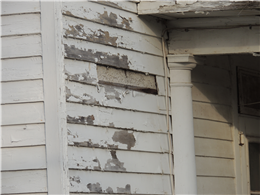Preventing Exterior Wood Rot on Your Historic Building
All the exterior wood elements on your historic house or building are vulnerable to rot. Although the wood used on your historic structure is likely old growth lumber that is more rot-resistant than today's lumber, it will still rot if it is not protected from moisture. You can prevent the harmful effects of moisture on your exterior wood elements in two key ways:
- Maintain a solid coating of paint on all wood surfaces.
- Ensure proper air flow throughout your house or building.
Paint: Your Best Defense Against Wood Rot
Your best defense against exterior wood rot is paint. Paint creates a protective film over the wood surface. Nearly all the exterior wood elements of your house or building were designed to be painted. Unpainted wood and peeling paint — and failed caulk — are all prescriptions for wood rot. Therefore, you should take measures to prevent paint failure and to properly prepare wood surfaces for new paint with caulk and primer.
Air Flow: Your Second-Best Defense Against Wood Rot
Your second-best defense against exterior wood rot is proper air flow. Wood can rot when moisture-laden air cannot move freely in and out of a structure and gets trapped in small spaces. You create warm, moist air in your house or building from many activities — cooking, taking showers, having plants, even breathing. The warm, moist vapor is attracted to the exterior walls. The vapor enters the walls through hairline wall cracks, electrical outlets and switches and window trim.
Building codes in Wisconsin require that when a new house or addition is built, it must have a vapor barrier. The plastic vapor barrier under the drywall stops the moisture-laden air from reaching the insulation and producing condensation. Historic houses and buildings with plaster walls have no vapor barrier under the plaster, so the moist air inside the structure reaches the insulation. Although this moist air can condensate if it does not pass all the way through the structure, old houses and buildings were designed to breath. Therefore, you should allow your historic structure to breath, with vapor passing freely through the plaster, framing and siding.

Installing insulation without properly considering the location of the dew point within the wall can trap moisture, create mold and cause paint failure. Here a clapboard was removed to show blown-in cellulose insulation trapping moisture. Source: Bob Yapp
Since some modern materials and technologies can interfere with this vapor transfer process, you should follow the practices below to keep your historic structure breathing as it should:
- Do not install loose-fit, open-cell insulation. Any loose-fit, open-cell insulation can slow vapor transfer. On cold nights, the cold outside air can mix with the warm air inside and cause moisture to condensate. Therefore, you should not install blown-in, loose-fibered cellulose or fiberglass insulation.
- Do not install vinyl siding or apply multiple coats of latex paint. Vinyl siding and multiple coats of exterior latex paint can also act like a vapor barrier and trap moisture. If the moisture reaches blown-in insulation in a wall cavity, it will create a wet mass at the bottom of the wallcavity. This wet mass will be an inviting place for termites, mold and dry rot. If the moisture enters the exterior sheathing and wood siding, it can cause permanent exterior paint failure, mold and wood rot.
- Do not caulk the bottom edge of wood siding or wood shingles. It might seem like a great idea, even logical, to caulk the bottom edge of all your horizontal siding to stop air infiltration. However, this practice will prevent the needed transfer of air that allows moisture to escape from your house or building. Your walls and wood elements cannot dry out without some exchange of moving air.

